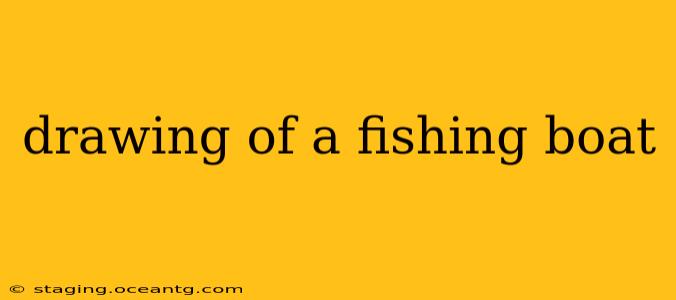Drawing a Fishing Boat: A Comprehensive Guide for Beginners and Beyond
Whether you're a seasoned artist or just starting out, drawing a fishing boat can be a rewarding experience. This guide will walk you through the process, from basic shapes to adding intricate details, catering to all skill levels. We'll cover various styles and techniques, ensuring you can create a depiction that captures the essence of this iconic vessel.
What are the different types of fishing boats?
Fishing boats come in a wide variety of shapes and sizes, each designed for a specific purpose and fishing method. Understanding these differences will help you choose the type of boat you want to draw and accurately portray its features. Some common types include:
- Trawlers: Large, powerful boats used for dragging nets across the seabed. They are characterized by their sturdy build and large capacity.
- Seiners: Used for encircling schools of fish with large nets. They often have a distinctive shape and powerful engines.
- Longliners: Deploy long lines with baited hooks, often used for catching deep-sea fish. They are typically longer and narrower than other types of fishing boats.
- Small fishing boats: These range from small rowboats to larger motorboats used for inshore fishing. Their design varies greatly depending on local traditions and fishing methods.
Choosing the type of fishing boat will greatly influence your drawing, affecting the overall shape, size, and details.
How do I start drawing a simple fishing boat?
Let's begin with a simple approach, perfect for beginners.
-
Basic Shapes: Start by sketching the hull using basic geometric shapes like rectangles and trapezoids. Lightly sketch these to easily erase and adjust as you go. Think of the overall silhouette of the boat.
-
The Cabin: Add a simple rectangular box for the cabin. Position this on the hull, considering its size relative to the boat.
-
The Mast (if applicable): If your chosen fishing boat has a mast, sketch a simple vertical line representing the mast, then add smaller lines for the rigging.
-
Details: Gradually add details like the bow, stern, and any other distinctive features. Remember to keep the lines light at this stage.
-
Refining the Sketch: Once you're happy with the basic proportions, refine the lines and add more details such as windows, railings, and fishing equipment.
What are some tips for drawing realistic fishing boats?
To achieve a more realistic portrayal, consider these tips:
-
Perspective: Practice drawing in perspective to give your boat a three-dimensional feel.
-
Shading and Light: Use shading and highlighting techniques to create depth and volume. Observe how light affects the boat's surfaces.
-
Details: Pay attention to the details—the texture of the wood, the fishing nets, the equipment on board. These details will bring your drawing to life.
-
Reference Images: Use reference images of real fishing boats to guide your drawing. This will help you accurately represent the boat's features and proportions.
How do I add details like nets and fishing equipment?
Adding details like nets and fishing equipment will significantly enhance your drawing. Consider:
-
Netting: Use a combination of lines and shapes to create the texture of the fishing net.
-
Fishing Rods: Sketch fishing rods with their characteristic curve and the lines and reels.
-
Other Equipment: Include other relevant equipment like buckets, boxes, and life vests to create a sense of realism.
What materials and tools are best for drawing fishing boats?
While the choice of tools is a matter of personal preference, here are some suggestions:
-
Pencils: A range of pencils (H, HB, B, 2B etc.) provides different line weights and shading options.
-
Eraser: A kneaded eraser is excellent for lifting graphite without damaging the paper.
-
Paper: Use good quality drawing paper that can handle erasing and shading.
-
Optional: Charcoal or colored pencils for adding richer tones and textures.
By following these steps and tips, and by practicing regularly, you'll be able to create stunning drawings of fishing boats. Remember, the key is to observe, practice, and enjoy the creative process!
